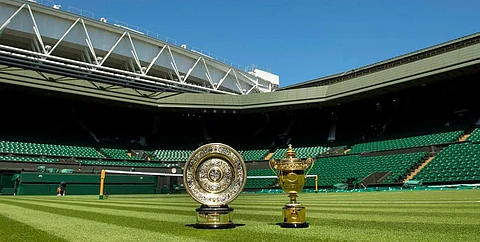
- Home
- Live Blog
- Breaking News
- Top Headlines
- Cities
- NE News
- Sentinel Media
- Sports
- Education
- Jobs

The Wimbledon Championship Trophy is presented annually to the gentlemen's singles tennis champion at the All England Club in Wimbledon, London. The Championships at Wimbledon are one of four Grand Slam tennis tournaments, or Majors played every year. It began in 1877 and is now the oldest standing and most admired professional tennis contest in the world.
Beginning in late June, the tournament is played out over two weeks on grass courts and in true British tradition of inequality for the genders the Gentlemen win a cup while the Ladies win a dish, properly referred to as the "Venus Rosewater Dish".
The cup is a silver gilt cup with a lid and a pineapple on topper. The cup bears the inscription "The All England Lawn Tennis Club Single Handed Champion of the World." The actual cup measures 18.5" inches tall and has a diameter of 7.5". The Cup has a classical style with two traditional handles with detailed engraving and a raised foot. The lid is formed with a pineapple top and a head covered with a winged helmet beneath each handle. There are also two decorative borders with floral art hand engraved and oval styled moldings on the bowl of the Cup and on the handles.
Prize money was first introduced to the tournament in 1968, the first year that professional athletes were allowed to compete in the Championships. Before this Wimbledon was actually a tournament designed for amateur tennis players only! In 2012 an estimated $24M will be awarded as prize money to all the winners at the tournament.
Venus Rosewater Dish:
The women’s Wimbledon tennis finale award is one of the world’s most famous and identifiable trophies. Officially named the Venus Rosewater Dish, the award is presented to the winner of the ladies singles tennis each year.
The unique and distinctive design generates curiosity for watchers of women’s tennis who are unfamiliar with the trophy’s origin.
A Rosewater Dish is designed to hold rose water, a popular perfume in the 16th century. Made popular by Elizabeth I, the rosewater perfume became a well-known fragrance and flavour of the age. The scent remained popular for hundreds of years, before falling out of fashion with the British in the 1960s.
Manufactured in 1864 by Birmingham silversmiths Elkington and Co, the dish was created from copper coated in silver. Coating one metal with another was extremely difficult during this time and was done via a complex, state of the art technique known as electroforming.
Now known as one of the sport’s most iconic trophies, the award was actually a replica of a rosewater dish made by German metalworker Caspar Enderlein. His work had been inspired by a 16th century decorative pewter, used as a rosewater dish. What happened to the dish between 1864 and its first presentation at the Women’s Wimbledon tournament in 1886 is still unknown. One theory is that it was donated by Queen Victoria as a prize, but this is still unconfirmed.